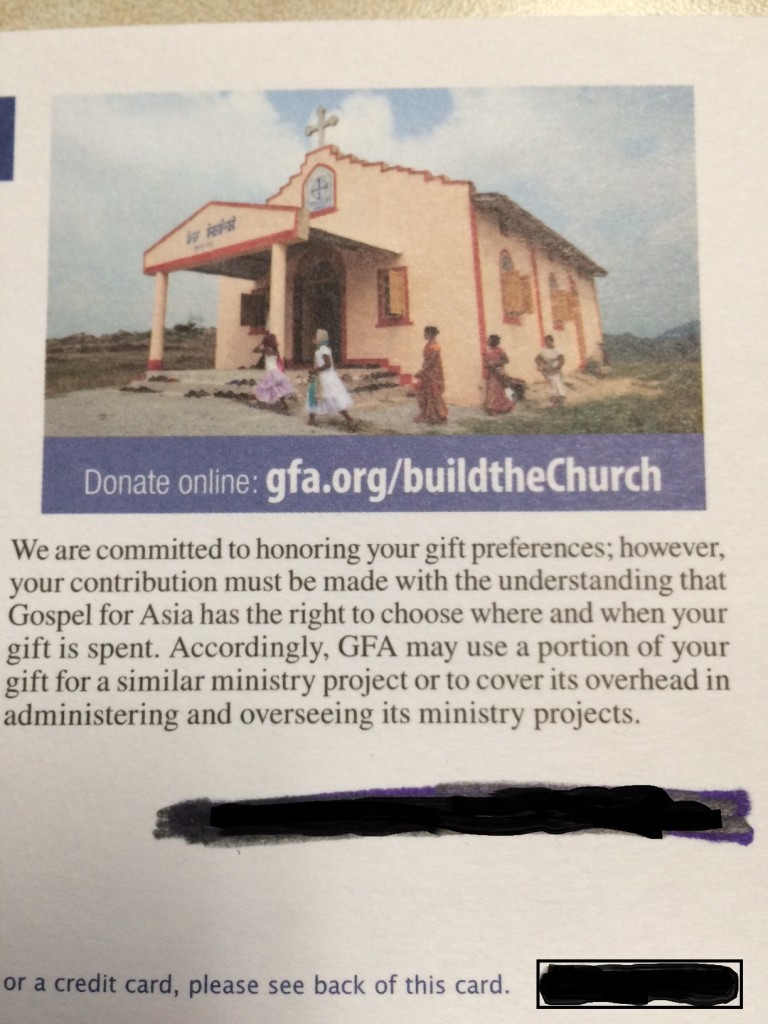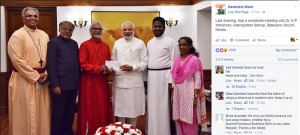In a mailing to donors asking for money for new church construction in India, Gospel for Asia has changed their promise about how funds are used.
On their website, GFA still promises that 100% of donations go to the “field” with nothing taken out for administrative costs.

However, in this new mailing, GFA tells donors:

I wonder how long the 100% promise will remain on the website. As of right now, the messages are contradictory. Website donors are still being misled. This new appeal appears to be how GFA has done business in the past. According to the ECFA, GFA has used donor money for purposes other than intended. This new mailing asks for money for churches (see the letter and enclosures), but the disclaimer tells the donor that the money may not go to build a church.
Given the documentation that GFA is using money in India to purchase land, schools, and medical centers for income production, donors should be aware that the money you hope goes to build a church may build a business instead.
Tag: Believers’ Church
Gospel for Asia Brags About Supplying a Drop of Water in New Delhi's Beleaguered Bucket
Gospel for Asia has been on a roll with press releases claiming to help India’s poor. The most recent one touts their efforts to ease a water crisis in the state of Delhi. The crisis has been exacerbated by political protests.
Gospel for Asia (GFA)-supported workers delivered nearly 4,000 gallons of water this week on World Water Day (March 22) to stricken residents of three areas in Delhi, hard-hit by a disruption in the city’s main supply source caused by a political protest.
Water was distributed to more than 1,000 people in three Delhi neighborhoods, with each household receiving two to 13 gallons. Residents there have suffered from severe water shortages, requiring residents to buy water daily until recently.
Perhaps 4,000 gallons sounds like a lot, but it is just a drop in a very large bucket.
According to a CNN report, it would take millions of gallons to make an impact.
As of Tuesday evening, the government had restored 80 million of the 580 million gallons that flow from the damaged canal daily. It is not clear when Delhi’s water supply will return to normal.
It costs about a dollar a gallon for commercially available bottled water in Delhi, so GFA’s big investment in the water crisis could have cost them a little over $4000.00 at most.
However, it was probably much less than that. According to the press release, GFA used tankers to bring in the water.
“We sent in tanker trucks to help those with life-threatening needs,” said K.P. Yohannan, founder and international director of GFA.
In 2012, one could rent a tanker which carries about the same amount of water GFA gave away for around $30. The same amount in the Fall of 2015 might go for as high as $50. The most recent source I found (last month) said tanker trucks providing the amount described by the press release could be secured for just over $60 (4000 rupees for 12000 liters).
Given the source of the press release, it probably took more money to pay for the publication of the release than it took to provide the water.
Even if the cost was around $4000, that is about 4 times what little Sayaan Ali needed to get life saving medical care and a whole lot less than the $74 million sitting in Indian banks from foreign contributors.
Hindustan Times Covers Gospel for Asia Scandal
 The second largest paper in India — Hindustan Times — has a front page story out today with a summary of the Gospel for Asia scandal.
The second largest paper in India — Hindustan Times — has a front page story out today with a summary of the Gospel for Asia scandal.
In it, we learn that GFA-India was contacted but without comment. GFA-Canada’s director Pat Emerick’s comments are getting more surreal. He told reporter Anirudh Bhattacharyya that the accusations again GFA are false and “even absurd, and we’ve communicated that clearly.”
Note to Mr. Emerick: engaging in clear communication is the last thing I could say about GFA.
This well written article should raise the profile of the situation internationally.
Gospel for Asia: Ganga River Project Donation Raises Questions About Priorities and Promises
 I reported last week that K.P. Yohannan met with Indian Prime Minister Narendra Modi. In the meeting, Yohannan gave 1 crore rupees (just shy of $150,000) to the Ganga Cleanliness Project.
I reported last week that K.P. Yohannan met with Indian Prime Minister Narendra Modi. In the meeting, Yohannan gave 1 crore rupees (just shy of $150,000) to the Ganga Cleanliness Project.
Compared to the millions still banked in India, $15ok isn’t a large sum.
Still, I wonder if donors intended those funds to help save the Ganga River. I also wonder what that money could have done for people.
While I was wondering, I thought of a story I read awhile back on the GFA website. The story of Lakshimi and her sister goes like this:
Nine-year-old Lakshmi works in a factory as a cigarette roller. She tells her sister’s story:
My sister is ten years old. Every morning at seven she goes to the bonded labor man, and every night at nine she comes home. He treats her badly; he hits her if he thinks she is working slowly or if she talks to the other children, he yells at her, he comes looking for her if she is sick and cannot go to work. I feel this is very difficult for her.
I don’t care about school or playing. I don’t care about any of that. All I want is to bring my sister home from the bonded labor man. For 600 rupees I can bring her home—that is our only chance to get her back.
We don’t have 600 rupees…we will never have 600 rupees [the equivalent of U.S.$14].
This story and another one I will tell below break my heart.
If the story of Lakshmi is true, nearly 11,000 kids could be rescued with a Ganga River sized donation. There is something sad and sickening about K.P. Yohannan currying favor with the Prime Minister while GFA offices all over the world beg for more money to help poor children.
The other story comes from an Indian observer of the Bridge of Hope program. A young elementary school aged boy named Sayaan Ali needed treatment for a kidney stone. He was a Bridge of Hope kid. His parents were not able to afford this treatment (about $1000 USD) so they requested help from their Bridge of Hope center and the local Believers’ Church diocese. Tragically, the Diocese failed to act on the request and the boy wasted away until he recently died a painful death. There was no bridge of hope for this young boy. His parents are devastated and the Prime Minister has another $150k for the Ganga River.
Believers’ Church and K.P. Yohannan own several state of the art hospitals which could have provided the care. These hospitals have been touted as means to minister to poor children like Sayaan. If only Sayaan and Lakshmi were important politicians, perhaps the church would have noticed.
Money really isn’t the issue for K.P. Yohannan and Believers’ Church. According to publicly available Indian government documents, GFA and ministry partners have just over $74-million sitting in bank accounts.
Shame on GFA and Believers Church for their photo ops with power. I call on K.P. Yohannan to answer for his use of donor funds and stop hiding behind his nameless board of directors.
More Indian NGOs Get Gospel for Asia Donations and Other GFA Developments
There have been a few new developments in the Gospel for Asia story:
2014 Audit
According to good sources who spoke on condition of anonymity because they may face retribution, the 2014 GFA audit is complete. However, GFA is not releasing it to anyone at this time on the advice of counsel. This seems like a flimsy reason. GFA representatives regularly claim they want to regain membership in the Evangelical Council for Financial Accountability and a clean audit available for review is one condition.
Gospel for Asia Out at National Religious Broadcasters
The Christian Post followed my story on GFA’s absence from membership in the NRB with a story citing a private letter to GFA ending membership near the end of 2015. Due to the fact that GFA lost membership in ECFA due to violations of standards, GFA also violated NRB’s membership requirement of financial integrity.
We also learned in that article that Johnnie Moore, editorial advisor to the Christian Post, also represents GFA in public relations concerning financial integrity issues. Seems like CP should have interviewed someone else for some balance. Thanks to CP and GFA’s editorial advisor, GFA got a nice free advertisement with no perspective from former employees.
More NGOs get GFA Donor Money
The website India Happenings has a nice run down of new financial information gleaned from the Indian Home Ministry about GFA. This analysis finds about $8-million given to unheard of NGOs in India from the shell LLCs here in the United States. Eventually all the money comes from GFA and ends up with Believers’ Church or GFA-India. This is a long way from accounting for the estimated $128-million unaccounted for over the past 8 years.
According to a source with knowledge of the arrangements, GFA first asked a trusted staff person to donate money to a LLC in order to get the entities started. GFA then gave money to a staffer in order to get the first donation on the books (e.g., Javier Mendoza for “Growth in Fraternity Trust” — see the India Happenings article). Then GFA used the LLCs as a channel to get cash to India. Staff were told that difficulty getting money to India necessitated these false front entities for the purpose of sending money to India and without the appearance that GFA sent it. Reportedly, GFA does not want the Indian government to know how much cash GFA is sending to India.
Money Might Be Flowing
I have gotten many communications from people in India since the lawsuit was filed. I am slowly following up on them (if you haven’t heard from me, be patient, I will do so). Many of them are reporting lots of cash flowing through Believers’ Church and GFA related organizations. Land and for profit schools are being purchased. It appears that GFA is trying get rid of lots of donor cash.